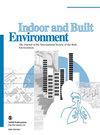Study on the effect of residential interior decoration on children’s respiratory diseases: A field trial conducted in Chongqing, China
IF 2.9
3区 工程技术
Q2 CONSTRUCTION & BUILDING TECHNOLOGY
引用次数: 0
Abstract
Pollutants such as formaldehyde, benzene series compounds and total volatile organic compounds (TVOC) released by residential interior decoration activities (including household renovation and new furniture) pose a severe threat to children’s respiratory health. To study the effect of indoor decoration on children’s respiratory diseases and provide suggestions to prevent it, we conducted a cross-sectional questionnaire survey amongst 6547 preschoolers from 34 kindergartens in Chongqing, China, and selected 39 houses to measure their indoor air pollutants concentrations. The results showed that household decoration, during pregnancy and early childhood, would increase the risk of children’s rhinitis, asthma and pneumonia. Vacancy time after the completion of decoration, furniture pieces and decoration materials significantly affected the concentration of formaldehyde, xylene and TVOC, which could pose a potential risk to children’s respiratory health. The concentration of xylene and TVOC and the incidence of children’s asthma and pneumonia were both negatively correlated with the vacancy time. Decoration materials such as composite and ceramic tile/stone/cement flooring and water-based/latex/oil-based paints emit more gaseous pollutants than solid wood flooring and wallpaper, respectively, which were more likely to increase the risk of children’s respiratory diseases. Adequate ventilation and air purification can reduce the impact of home decoration.住宅室内装饰对儿童呼吸道疾病影响的研究:在中国重庆进行的实地试验
住宅室内装修活动(包括家居装修和新家具)释放的甲醛、苯系物和总挥发性有机物(TVOC)等污染物对儿童呼吸系统健康构成严重威胁。为了研究室内装修对儿童呼吸道疾病的影响,并提出预防建议,我们对重庆市 34 所幼儿园的 6547 名学龄前儿童进行了横断面问卷调查,并选取了 39 栋房屋测量其室内空气污染物浓度。结果显示,孕期和幼儿期的家庭装修会增加儿童患鼻炎、哮喘和肺炎的风险。装修完成后的空置时间、家具和装修材料对甲醛、二甲苯和 TVOC 的浓度有明显影响,可能对儿童的呼吸道健康造成潜在风险。二甲苯和 TVOC 的浓度以及儿童哮喘和肺炎的发病率均与空置时间呈负相关。复合地板和瓷砖/石材/水泥地板以及水性/乳胶/油性涂料等装修材料分别比实木地板和墙纸排放更多的气体污染物,更有可能增加儿童患呼吸道疾病的风险。适当的通风和空气净化可减少家居装饰的影响。
本文章由计算机程序翻译,如有差异,请以英文原文为准。
求助全文
约1分钟内获得全文
求助全文
来源期刊

Indoor and Built Environment
环境科学-工程:环境
CiteScore
6.40
自引率
25.00%
发文量
130
审稿时长
2.6 months
期刊介绍:
Indoor and Built Environment publishes reports on any topic pertaining to the quality of the indoor and built environment, and how these might effect the health, performance, efficiency and comfort of persons living or working there. Topics range from urban infrastructure, design of buildings, and materials used to laboratory studies including building airflow simulations and health effects. This journal is a member of the Committee on Publication Ethics (COPE).
 求助内容:
求助内容: 应助结果提醒方式:
应助结果提醒方式:


